Establishment of Buddha Sasana in Lanka by Arahat Mahinda
Posted on November 3rd, 2012
Article 14
The Arrival of Buddhism in Sri Lanka:ƒÆ’-¡ƒ”š‚ 
According to the chronicles, Emperor Asoka was crowned in the year 218 of the Buddhist era (i.e., 268 BCE).ƒÆ’-¡ƒ”š‚ Buddhism gained momentum as a form of religion during this period in India.ƒÆ’-¡ƒ”š‚ Asoka was from the Mauryan family. ƒÆ’-¡ƒ”š‚ His grandfather Candra Gupta founded the Mauryan Empire in 325 BC, conquering northern and central India. ƒÆ’-¡ƒ”š‚ Later, Candra Gupta became a practicing Jain and relinquished his thrown to his son Bindusara. ƒÆ’-¡ƒ”š‚ Like his father Bindusaara and grandfather Chandragupta, Asoka was a follower of the Brahmin faith.ƒÆ’-¡ƒ”š‚ In the early years of his supremacy, he was also eager to expand his territories and was known as Chandasoka (Asoka the unruly one).
Emperor Asoka and Buddhism in India: ƒÆ’-¡ƒ”š‚
 In the eighth year of his reign, he conquered the territory of Kaalinga, a victory that came with a large loss of lives, and the carnage of this war caused him much grief.ƒÆ’-¡ƒ”š‚ Presumably, this psychological state attracted him to the humanistic teachings of Buddhism, which was then disseminating throughout India at that time.
In the eighth year of his reign, he conquered the territory of Kaalinga, a victory that came with a large loss of lives, and the carnage of this war caused him much grief.ƒÆ’-¡ƒ”š‚ Presumably, this psychological state attracted him to the humanistic teachings of Buddhism, which was then disseminating throughout India at that time.
King Asoka accidentally met an ascetic, samenara Nigrodha, a son of Prince Sumana, the eldest of King Bindusara whom he assassinated. ƒÆ’-¡ƒ”š‚ Asoka invited him into his palace.ƒÆ’-¡ƒ”š‚ Following their conversations, the highly intelligent samenara delivered an instructive discourse, a stanza of the Dhammapada: ƒÆ’‚¢ƒ¢-¡‚¬ƒ…-Appamado amata padanƒÆ’‚¢ƒ¢-¡‚¬ƒ”š‚¦,ƒÆ’‚¢ƒ¢-¡‚¬ƒ”š‚ ƒÆ’‚¢ƒ¢-¡‚¬ƒ…-mindfulness is the path of deathlessnessƒÆ’‚¢ƒ¢-¡‚¬ƒ”š‚, to king Asoka.ƒÆ’-¡ƒ”š‚ As per the chronicles, King Asoka was so impressed, he offered continuous gifts of food to any B uddhist monks within his territories and became humanistic.ƒÆ’-¡ƒ”š‚ The instructive discourse of stanza from the Dhammapada was:
uddhist monks within his territories and became humanistic.ƒÆ’-¡ƒ”š‚ The instructive discourse of stanza from the Dhammapada was:
Heedfulness is the path to Deathlessness.
Heedfulness is the path to death.ƒÆ’-¡ƒ”š‚ The Heedful do not die,
The Heedful are like unto the dead.
ƒÆ’-¡ƒ”š‚ Dhammapada 21 (Appamadawagga)
 The teachings of the Buddha appealed to Emperor Asoka, and he completely changed and became a Buddhist, after which he helped Buddhism to flourish in India.ƒÆ’-¡ƒ”š‚ He inculcated the teachings of the Buddha in many aspects of life in India and set up edicts of morality in his kingdom so that his subjects would adhere to them and his successors might continue the work.ƒÆ’-¡ƒ”š‚ He followed those moral codes and set an example for others.ƒÆ’-¡ƒ”š‚ During his tenure as the king, he is said to have built 84,000 stupas, and the monks were provided lifeƒÆ’‚¢ƒ¢-¡‚¬ƒ¢-¾‚¢s necessities.ƒÆ’-¡ƒ”š‚ These acts of piousness later lead him to be called Dharmasoka (Asoka the Pious).
The teachings of the Buddha appealed to Emperor Asoka, and he completely changed and became a Buddhist, after which he helped Buddhism to flourish in India.ƒÆ’-¡ƒ”š‚ He inculcated the teachings of the Buddha in many aspects of life in India and set up edicts of morality in his kingdom so that his subjects would adhere to them and his successors might continue the work.ƒÆ’-¡ƒ”š‚ He followed those moral codes and set an example for others.ƒÆ’-¡ƒ”š‚ During his tenure as the king, he is said to have built 84,000 stupas, and the monks were provided lifeƒÆ’‚¢ƒ¢-¡‚¬ƒ¢-¾‚¢s necessities.ƒÆ’-¡ƒ”š‚ These acts of piousness later lead him to be called Dharmasoka (Asoka the Pious).
Qualities of Emperor Asoka the Great: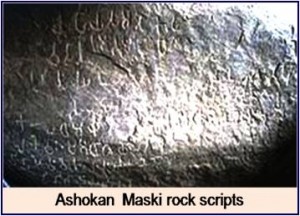
The Dharma propagated by Asoka the Pious is explained in terms of moral precepts, based on the right behavior and doing good deeds (Rock Pilar Nb7, S. Dharmika), pardons and kindness to prisoners (Rock Pilar Edict Nb5, S. Dhammika), and respect for environment and animal life (Rangarajan, M. 2001, India’s Wildlife History, p 8).ƒÆ’-¡ƒ”š‚ Moreover, because he adopted BuddhaƒÆ’‚¢ƒ¢-¡‚¬ƒ¢-¾‚¢s teachings of the practice of ƒÆ’‚¢ƒ¢-¡‚¬ƒ…-Dasa-Raja-DharmaƒÆ’‚¢ƒ¢-¡‚¬ƒ”š‚ to govern the entire empire, he strictly adhered to spreading the moral virtues of Buddhism (Minor Rock Edict Nb3, S. Dhammika).
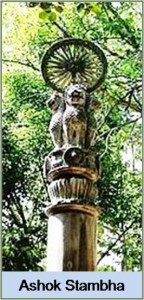 He committed to spreading the teachings of the Buddha, to ensuring that the teachings were followed, and to ensuring that his countrymen believed in the next birth (Rock Edict Nb11, S. Dhammika), particularly in the monastic circles.ƒÆ’-¡ƒ”š‚ He also extended his activities to religious exchanges (Rock Edict NB1 and Nb7, S. Dhammika), offers of faith and loyalty to Buddha, Dhamma, and Sangha (Edict Nb5, S. Dhammika), and medicinal treatments (Rock Edict Nb2, S. Dhammika) (India: The Ancient Past, Burjor Avari, Routledge, ISBN 0-415-35615-6).
He committed to spreading the teachings of the Buddha, to ensuring that the teachings were followed, and to ensuring that his countrymen believed in the next birth (Rock Edict Nb11, S. Dhammika), particularly in the monastic circles.ƒÆ’-¡ƒ”š‚ He also extended his activities to religious exchanges (Rock Edict NB1 and Nb7, S. Dhammika), offers of faith and loyalty to Buddha, Dhamma, and Sangha (Edict Nb5, S. Dhammika), and medicinal treatments (Rock Edict Nb2, S. Dhammika) (India: The Ancient Past, Burjor Avari, Routledge, ISBN 0-415-35615-6).
Asoka’s famous rock edict reads, ƒÆ’‚¢ƒ¢-¡‚¬ƒ…-May the Dhamma last as long as my sons and grandsons, and the sun and the moon will be, and may the people follow the path of the Dhamma, for if one follows the path, happiness in this and in the other worlds will be attained.ƒÆ’‚¢ƒ¢-¡‚¬ƒ”š‚ƒÆ’-¡ƒ”š‚ Even today, the Asoka Chakra (the Wheel of Asoka) dominates the national flag of India.ƒÆ’-¡ƒ”š‚ Asoka, earlier as the viceroy of Udenipura (now Ujjain) in Avanti, fell in love with a beautiful woman named Devi (the second wife), the daughter of a wealthy merchant of Vidisa, who bore him two children.ƒÆ’-¡ƒ”š‚ One was Mahinda (Mahendra), and the other was Sanghamitta (Sanghamitra), both of whom entered the holy order of a bhikku and bhikkuni in fulfilment of the wish of their father Asoka.ƒÆ’-¡ƒ”š‚ 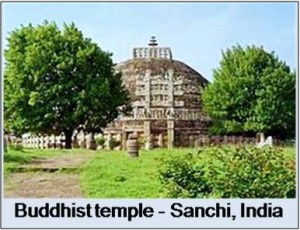
Prince Mahinda entered the order at the age of 26 years and elevated his spiritual position to that of an Arahat, having eliminated all passions pertaining to mundane existence. ƒÆ’-¡ƒ”š‚ These two illustrious disciples were famous for their godliness, attainments, learning, and profound knowledge of the Dhamma.ƒÆ’-¡ƒ”š‚ During the reign of Asoka, great numbers of people joined the Order of Sangha and held to the teachings of the Buddha.
Organizing the Third Buddhist Council:
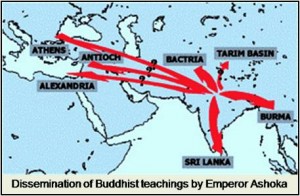 At that time of Asoka, there were 18 sects of Buddhism; some heretical monks were causing disreputation to the Sasana.ƒÆ’-¡ƒ”š‚ To overcome these issues, the King invited the highly learned Moggaliputta Tissa thera to organize a Council.ƒÆ’-¡ƒ”š‚ He accepted the invitation with the view of protecting the sasana.
At that time of Asoka, there were 18 sects of Buddhism; some heretical monks were causing disreputation to the Sasana.ƒÆ’-¡ƒ”š‚ To overcome these issues, the King invited the highly learned Moggaliputta Tissa thera to organize a Council.ƒÆ’-¡ƒ”š‚ He accepted the invitation with the view of protecting the sasana.
King Asoka organized the Third Buddhist Council under his patronage at the Asokarama.ƒÆ’-¡ƒ”š‚ This happened at the 17th year of the rule of King Asoka, then 72 years old, 236 years after the BuddhaƒÆ’‚¢ƒ¢-¡‚¬ƒ¢-¾‚¢s Mahaparinibbana.ƒÆ’-¡ƒ”š‚ This Council was attended by one thousand learned monks under the guidance of Moggaliputta Tissa, at Paataliputta, as per the Pali Canon of the Theravada.ƒÆ’-¡ƒ”š‚ ƒÆ’-¡ƒ”š‚ 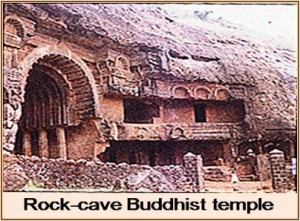
This congregation lasted 9 months and during which, several key decisions were made including, eternalism (Sassata Vadi) and nihilism (Uccheda Vadi), expelling the myths and false doctrines, and the BuddhaƒÆ’‚¢ƒ¢-¡‚¬ƒ¢-¾‚¢s teachings regarding non-discrimination, differentiation, and analytical and critical teaching (Vibhajja vadi), call attention to the Theravada traditional Buddhist teachings.ƒÆ’-¡ƒ”š‚ Moggaliputta Tissa thera called the Sangha to protect the Dhamma and the Sasana for the long run, and the teachings were compiled into Kathavatthu.
Another key decision made at this Buddhist Council was to disseminate the BuddhaƒÆ’‚¢ƒ¢-¡‚¬ƒ¢-¾‚¢s teachings to neighbouring countries.ƒÆ’-¡ƒ”š‚ Missionaries were to be sent to help people, while the preaching of Buddhism and the establishment of the Buddha Sasana in other regions and countries would occur.ƒÆ’-¡ƒ”š‚ Because of this landmark decision, Venerable Moggaliputta Tissa, with the patronage of King Ashoka, arranged to send several groups of highly learned monks to neighbouring countries as Buddhist ambassadors.
Most of these groups, with the exception of Thamapanni (Lanka), consisted of five monks, competent to perform ordination and most sanghakamma.ƒÆ’-¡ƒ”š‚ These missions include sending Majjhantika Thera to Kaasmira-Gandhaara and Afghanistan; Mahaadeva Thera to Mahisamandala; Rakkhita Thera to Vanavaasi and Yavana; Yona-Dhammarakkhita Thera to Aparaantaka; Dhammarakkhita Thera to Mahaarattha; Mahaarakkhita Thera to Yonaloka; to Majjhima Thera Himavanta/ Himalya; Theras Sona and Uttara to Suvanna Bhumi.ƒÆ’-¡ƒ”š‚ The most successful and lasting spread of Theravada Buddhism was the mission to Lanka by King AsokaƒÆ’‚¢ƒ¢-¡‚¬ƒ¢-¾‚¢s own children, venerable Mahinda and later, Sanghamitta thera together with theras Itthiya, Uttiya, Sambala, and Bhaddasaala to Tambapanni / Lanka.
Buddhist Mission to Sri Lanka
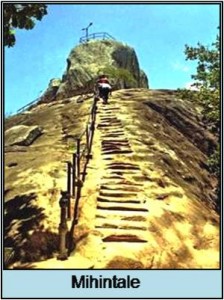 Arahat Mahinda was requested to go to Lanka by his father, the emperor Asoka, who facilitated the decisions that were made at the Buddhist Council.ƒÆ’-¡ƒ”š‚ Venerable Mahinda was 32 years old when he undertook the mission to Lanka.ƒÆ’-¡ƒ”š‚ He had adopted the religious life at the age of 20, mastered the doctrines, and attained the highest spiritual life (i.e., Arahatship).ƒÆ’-¡ƒ”š‚ According to legend, Venerable Mahinda visited his relatives at Dakkhinaagiri and his mother at Vedisagiri along with his companions.ƒÆ’-¡ƒ”š‚ His mother Devi, whom Asoka had married, was living at Vedisagiri at that time.ƒÆ’-¡ƒ”š‚ Having stayed for 6 months at Dakkhinaagiri and a month at Vedisagiri, v
Arahat Mahinda was requested to go to Lanka by his father, the emperor Asoka, who facilitated the decisions that were made at the Buddhist Council.ƒÆ’-¡ƒ”š‚ Venerable Mahinda was 32 years old when he undertook the mission to Lanka.ƒÆ’-¡ƒ”š‚ He had adopted the religious life at the age of 20, mastered the doctrines, and attained the highest spiritual life (i.e., Arahatship).ƒÆ’-¡ƒ”š‚ According to legend, Venerable Mahinda visited his relatives at Dakkhinaagiri and his mother at Vedisagiri along with his companions.ƒÆ’-¡ƒ”š‚ His mother Devi, whom Asoka had married, was living at Vedisagiri at that time.ƒÆ’-¡ƒ”š‚ Having stayed for 6 months at Dakkhinaagiri and a month at Vedisagiri, v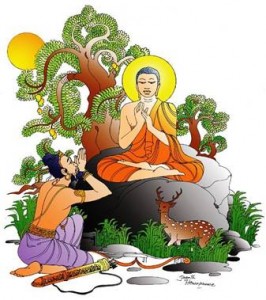 enerable Mahinda visited Lanka.
enerable Mahinda visited Lanka.
The enthronement of King Devanampiya-Tissa (the second son of Mutasiva), was found suitable to fit the occasion, and Arahat Mahinda, with his companions, left Vedisagiri vihara bound for Lanka.ƒÆ’-¡ƒ”š‚ They were accompanied by amoung others, Bhanduka upasaka, the lay disciple.ƒÆ’-¡ƒ”š‚ According to Mahavamsa (Ch. 13:20), Arahat Mahinda and his companions, altogether six, arrived atop the Missaka Mountain (now called Mihintale).ƒÆ’-¡ƒ”š‚ This spot is now known as the aradhana-gala, where the historic MahindaƒÆ’‚¢ƒ¢-¡‚¬ƒ¢¢”š¬‚Tissa meeting took place.
Devanampiya-Tissa was a friend of Asoka even before he became the king, although the two had never met.ƒÆ’-¡ƒ”š‚ The first thing that Devanampiya-Tissa did when he became the king was to send envoys to Emperor Asoka.ƒÆ’-¡ƒ”š‚ The diplomat, when returned, brought among other things the following message from Asoka:
“Aha.m BuddhaƒÆ’†’ƒ”š‚± ca DhammaƒÆ’†’ƒ”š‚± ca SanghaƒÆ’†’ƒ”š‚± ca sara.na.mgato upaasakatta.m vedesi.m Saakyaputtassa Sasana tvamp’imaani ratanaani uttamaani naruttama citta.m
pasaadayitvaana saddhaaya sara.na.m bhaja.”
ƒÆ’-¡ƒ”š‚ ƒÆ’‚¢ƒ¢-¡‚¬ƒ…-I have taken refuge in the Buddha, his Doctrine and his Order, I have declared myself a lay-disciple in the religion of the Saakya son; seek then, refuge in these best of gems, converting your mind with believing heart.ƒÆ’‚¢ƒ¢-¡‚¬ƒ”š‚
This message of Asoka was conveyed to King Devanampiya-Tissa in the month of Vesak, and it was the Full Moon day of the following month, Poson, that Venerable Mahinda arrived in Lanka.
 Arrival of Venerable Mahinda in Sri Lanka
Arrival of Venerable Mahinda in Sri Lanka
On the Full Moon day of the month of Poson (June 250 BCE; i.e., 237 years after the Parinibbana of the Buddha), Arahat Mahinda and his companions arrived at the Silakuuta of the pleasant Missaka hill, 12 kilometres (eight miles) east of Anuradhapura.ƒÆ’-¡ƒ”š‚ The Venerable perceived that he would meet the king there on that day.ƒÆ’-¡ƒ”š‚ He met King Devanampiya-Tissa (267 BCE) of Lanka atop the Mihintale rock, then known as Missaka-pabbata.ƒÆ’-¡ƒ”š‚ This historic meeting paved the way for the establishment of Buddhism in Lanka.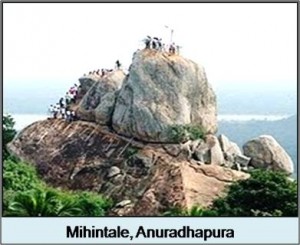
Among the above-mentioned companions of Mahinda were the samanera Sumana, who was the son of Sanghamitta, and the lay disciple Bhanduka, who was the son of queen Devi’s sisterƒÆ’‚¢ƒ¢-¡‚¬ƒ¢-¾‚¢s daughter, who had become an Anaagaami.
The first meeting of the king of Lanka and the Venerable Mahinda is described in detail in the chronicles of Lanka.ƒÆ’-¡ƒ”š‚ Since that day, the Full Moon day of Poson is celebrated as a holiday and national festival day in Lanka.ƒÆ’-¡ƒ”š‚ Men, women, and children engage in religious, compassionate, and educational activities.
The king and a large group of followers went to the Mihintale hills on a deer-hunting expedition.ƒÆ’-¡ƒ”š‚ There he saw the Venerable with shaven head dressed in yellow robes, of noble and distinguished appearance uttering the following words:
“Sama.naa maya.m Mahaaraaja Dhammaraajassa saavakaa tav’eva anukampaaya Jambudiipaa idhaagataa.”
ƒÆ’‚¢ƒ¢-¡‚¬ƒ…-We are the disciples of the Lord Buddha and the Dhamma.ƒÆ’-¡ƒ”š‚ In compassion toward you, Mahaa-raja, we have come here from India.ƒÆ’‚¢ƒ¢-¡‚¬ƒ”š‚
When he heard these words of the Venerable, the king laid aside his bow and arrow, approached venerable Mahinda, and sat down near him.ƒÆ’-¡ƒ”š‚ Mahinda then had a conversation with the king and, realizing that the king was intelligent enough to comprehend the Dhamma, preached the Cuulahatthipadopama Sutta: ƒÆ’‚¢ƒ¢-¡‚¬ƒ…-simile on the foot of an elephant.ƒÆ’‚¢ƒ¢-¡‚¬ƒ”š‚ƒÆ’-¡ƒ”š‚ This Sutta gives a broad, but clear, idea of the Buddha, Dhamma, and Sangha, and describes how one becomes a Buddhist and a bhikku.ƒÆ’-¡ƒ”š‚ At the end of the discourse, the king and his entourage embraced the new faith; this was the formal introduction of Buddhism to Lanka (Mhv. 14:22).ƒÆ’-¡ƒ”š‚ As per the legend, within a month, more than 40,000 Lankan people embraced Buddhism.
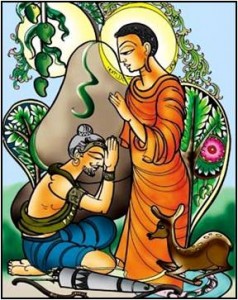 The first conversation impressed the King, and he immediately capitulated to the wisdom and piety displayed by the venerable Mahinda.ƒÆ’-¡ƒ”š‚ The king warmly invited the monks to the city.ƒÆ’-¡ƒ”š‚ Venerable Mahinda and his companions spent their first day in Lanka at Mihintale, where he initiated his first religious act by admitting to the Order the lay follower Bhanduka, who had accompanied him from India.
The first conversation impressed the King, and he immediately capitulated to the wisdom and piety displayed by the venerable Mahinda.ƒÆ’-¡ƒ”š‚ The king warmly invited the monks to the city.ƒÆ’-¡ƒ”š‚ Venerable Mahinda and his companions spent their first day in Lanka at Mihintale, where he initiated his first religious act by admitting to the Order the lay follower Bhanduka, who had accompanied him from India.
On the following day, Venerable Mahinda and the group of monks arrived at Anuradhapura.ƒÆ’-¡ƒ”š‚ He preached the Petavatthu, the Vimaanavatthu, and the Sacca-samyutta to the royal household.ƒÆ’-¡ƒ”š‚ The people of the city, who heard of the venerable, assembled near the palace gate to see and hear him, and the king prepared a hall outside the palace so that the people could listen to the most venerable and his monks. ƒÆ’-¡ƒ”š‚ On this occasion, legends state, venerable Mahinda preached the Devaduuta Sutta (Majjhima Nikaaya, No. 130). ƒÆ’-¡ƒ”š‚ To accommodate the extensive crowd, the Nandana garden in the royal park was constructed for additional sermons of the venerable Mahinda, including the sermon of Baalapandita Sutta (Majjhima Nikaaya, No. 129).
The king granted permission to the newly arrived Sangha to use the royal park Mahaamegha as their residence.ƒÆ’-¡ƒ”š‚ Thus was established the Mahaa-vihaara, which became the first celebrated sect of the Buddhist religion.ƒÆ’-¡ƒ”š‚ Having spent a month in the Mahaamegha Park, the Venerable returned to Mihintale for vassa, the rainy season retreat.ƒÆ’-¡ƒ”š‚ This was the beginning of the establishment of the Cetiyagiri-vihaara, another great monastic institution of early Buddhist establishment in Lanka. ƒÆ’-¡ƒ”š‚ According to Mahavamsa, Ling Devanampiya-TissaƒÆ’‚¢ƒ¢-¡‚¬ƒ¢-¾‚¢s nephew, Aritta, and 55 of others were the first on the island to receive the ordination (pabajja) by the Arahat Mahinda.
The arrival of Arahat Mahinda in Lanka brought not only pristine Buddhism, but also a true and lasting socio-religious revolution, changing the life and habitat of the people for the better; peace and prosperity.ƒÆ’-¡ƒ”š‚ The establishment of the Buddha Sasana in the island was the greatest step to moulding the character of the masses, leading to spiritual awareness and high morality, Heal-culture, and the peaceful progress of the country.ƒÆ’-¡ƒ”š‚ 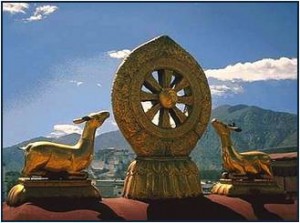
When Arahat Mahinda came to Sri Lanka, he brought with him the Theravada canon, the conventional Buddhism, preserved in memory by oral tradition and finally redacted at the Third Buddhist Council held at Pataliputra (now Patna), under the leadership of the Maha Thera Moggaliputta Tissa. ƒÆ’-¡ƒ”š‚ The next article (#15) describes the establishment of the Bhikkuni Sasana in Lanka by Venerable Sangamitta.
Motto: Governing a country or a society with the BuddhaƒÆ’‚¢ƒ¢-¡‚¬ƒ¢-¾‚¢s teachings of ƒÆ’‚¢ƒ¢-¡‚¬ƒ…-Dasa-raja-darmaƒÆ’‚¢ƒ¢-¡‚¬ƒ”š‚ would eliminate unrest, uncertainties, inequalities, and corruption, while promoting peace, harmony, unity, prosperity, and happiness.ƒÆ’-¡ƒ”š‚ It also would prevent internal fighting and external invasions.
ƒÆ’‚¢ƒ¢-¡‚¬ƒ…-Among tigers, lions, leopards & bears I lived in the wood.
No one was frightened of me, nor did I fear anyone.
Uplifted by such universal friendliness I enjoyed the forest.
Finding great solace in sweet silent solitudeƒÆ’‚¢ƒ¢-¡‚¬ƒ”š‚
(Suvanna-sama Jataka 540)
Note: Some of the material, pictures, poems, and stanzas in these writings may have been published previously, including on the Internet (such as http://what-buddha-said.net and Buddha.direct.net) or obtained from various sources (modified with permission).ƒÆ’-¡ƒ”š‚ The author sincerely thanks all contributors of such materials for their generosity. ƒÆ’-¡ƒ”š‚ We anticipate that the brief articles on meditation, Buddhism, and Buddhist philosophy that appear in this column will initiate healthy and positive discussions.
May the Noble Triple Gem bless you
Sunil J. Wimalawansa
Professor of Medicine, Endocrinology, Physiology, & Integrative Biology